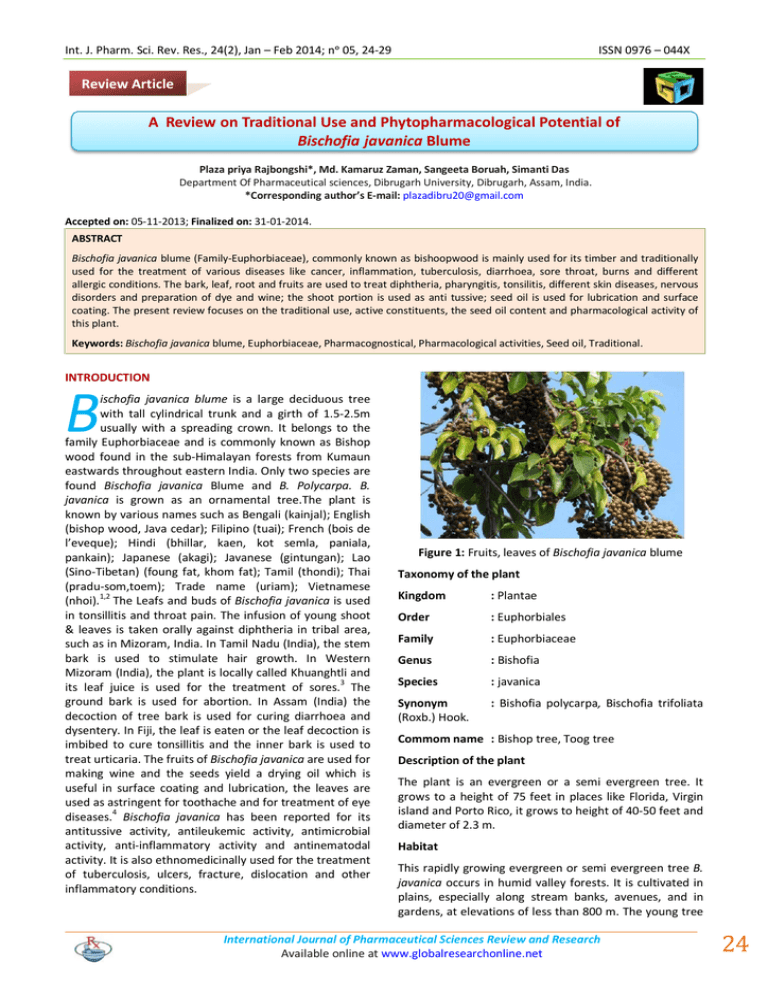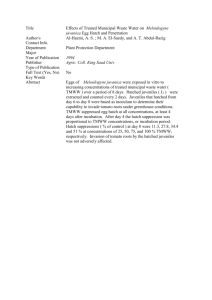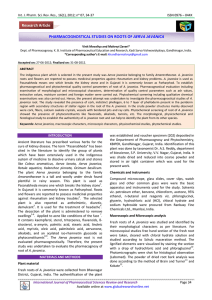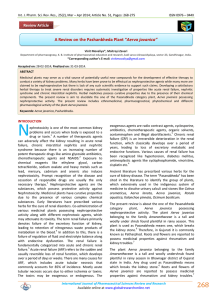Document 13309545
advertisement

Int. J. Pharm. Sci. Rev. Res., 24(2), Jan – Feb 2014; nᵒ 05, 24-29 ISSN 0976 – 044X Review Article A Review on Traditional Use and Phytopharmacological Potential of Bischofia javanica Blume Plaza priya Rajbongshi*, Md. Kamaruz Zaman, Sangeeta Boruah, Simanti Das Department Of Pharmaceutical sciences, Dibrugarh University, Dibrugarh, Assam, India. *Corresponding author’s E-mail: plazadibru20@gmail.com Accepted on: 05-11-2013; Finalized on: 31-01-2014. ABSTRACT Bischofia javanica blume (Family-Euphorbiaceae), commonly known as bishoopwood is mainly used for its timber and traditionally used for the treatment of various diseases like cancer, inflammation, tuberculosis, diarrhoea, sore throat, burns and different allergic conditions. The bark, leaf, root and fruits are used to treat diphtheria, pharyngitis, tonsilitis, different skin diseases, nervous disorders and preparation of dye and wine; the shoot portion is used as anti tussive; seed oil is used for lubrication and surface coating. The present review focuses on the traditional use, active constituents, the seed oil content and pharmacological activity of this plant. Keywords: Bischofia javanica blume, Euphorbiaceae, Pharmacognostical, Pharmacological activities, Seed oil, Traditional. INTRODUCTION B ischofia javanica blume is a large deciduous tree with tall cylindrical trunk and a girth of 1.5-2.5m usually with a spreading crown. It belongs to the family Euphorbiaceae and is commonly known as Bishop wood found in the sub-Himalayan forests from Kumaun eastwards throughout eastern India. Only two species are found Bischofia javanica Blume and B. Polycarpa. B. javanica is grown as an ornamental tree.The plant is known by various names such as Bengali (kainjal); English (bishop wood, Java cedar); Filipino (tuai); French (bois de l’eveque); Hindi (bhillar, kaen, kot semla, paniala, pankain); Japanese (akagi); Javanese (gintungan); Lao (Sino-Tibetan) (foung fat, khom fat); Tamil (thondi); Thai (pradu-som,toem); Trade name (uriam); Vietnamese (nhoi).1,2 The Leafs and buds of Bischofia javanica is used in tonsillitis and throat pain. The infusion of young shoot & leaves is taken orally against diphtheria in tribal area, such as in Mizoram, India. In Tamil Nadu (India), the stem bark is used to stimulate hair growth. In Western Mizoram (India), the plant is locally called Khuanghtli and 3 its leaf juice is used for the treatment of sores. The ground bark is used for abortion. In Assam (India) the decoction of tree bark is used for curing diarrhoea and dysentery. In Fiji, the leaf is eaten or the leaf decoction is imbibed to cure tonsillitis and the inner bark is used to treat urticaria. The fruits of Bischofia javanica are used for making wine and the seeds yield a drying oil which is useful in surface coating and lubrication, the leaves are used as astringent for toothache and for treatment of eye 4 diseases. Bischofia javanica has been reported for its antitussive activity, antileukemic activity, antimicrobial activity, anti-inflammatory activity and antinematodal activity. It is also ethnomedicinally used for the treatment of tuberculosis, ulcers, fracture, dislocation and other inflammatory conditions. Figure 1: Fruits, leaves of Bischofia javanica blume Taxonomy of the plant Kingdom : Plantae Order : Euphorbiales Family : Euphorbiaceae Genus : Bishofia Species : javanica Synonym (Roxb.) Hook. : Bishofia polycarpa, Bischofia trifoliata Commom name : Bishop tree, Toog tree Description of the plant The plant is an evergreen or a semi evergreen tree. It grows to a height of 75 feet in places like Florida, Virgin island and Porto Rico, it grows to height of 40-50 feet and diameter of 2.3 m. Habitat This rapidly growing evergreen or semi evergreen tree B. javanica occurs in humid valley forests. It is cultivated in plains, especially along stream banks, avenues, and in gardens, at elevations of less than 800 m. The young tree International Journal of Pharmaceutical Sciences Review and Research Available online at www.globalresearchonline.net 24 Int. J. Pharm. Sci. Rev. Res., 24(2), Jan – Feb 2014; nᵒ 05, 24-29 ISSN 0976 – 044X is shade-resistant and prefers moist condition. It requires growing well in sandy soil that is thick and fertile. It grows up to an altitude of 1800 m. The species is usually found scattered in primary and old secondary dry and deciduous forest or monsoon forest. Occasionally plant can be in evergreen forest, swamp and teak forest. The plant requires an annual rainfall of 1250-2500 mm; also capable of growing in dry places provided access to ground water. It tends to be evergreen in moist localities and deciduous in dry areas. The type of soil needed by the plant is deep, loose soils such as sandy, rocky or loamy soils with sufficient water content, occasionally it is found on limestone. It can stand moderate shade and slight frost, but not drought.1-4 glabrous, shortly pedecellate; corolla segment 5, obtuse, concave, concealing the anthers; stamens 5; anthers globular pistillode present in the form of a flate disc. Female flowers are pedicelled (longer than male flower), 15-17cm long; sepals ovate, cadueous, styles are linear, entire ovary is 3 or 4-celled ovules 2 in each cell.1,2 Distribution Wood The genus is found in southern and south eastern Asia to Australia and Polynesia. They also occur in south western, central, eastern, and southern China. Bischofia javanica is widely distributed in the Pacific Islands, Malaysia, SE Asia, Southern China, possibly also in Tonga and Samoa including Taiwan, Southern Japan, Myanmar, and India. It is also found in New Caledonia, Tonga, Rarotonga, Fiji, Niue, Vanuatu, and Samoa. B. javanica is native to the Chinese provinces of Kwangtung, Fukien, Kweichow, Yunnan and Hupeh and may also be to Burma, India, the Andaman Islands, tropical Australia, Malaysia and Polynesia.1,2 The wood of Bischofia javanica is red, moderately hard but rather rough grained; heart wood is small, darker; weight 40-50 lbs per ft. It is more durable in water and 1,2 used for various purposes. PHARMACOGNOSTICAL CHARACTERISTICS Bischofia javanica blume is a large deciduous tree with tall cylindrical trunk .It is an evergreen tree up to 20m in length and 9-12m in height with a cylindrical bole, a girth of 1.5-2.5m and a spreading crown. .This tree is found in the Sub-Himalayan forests from Kumaun eastwards throughout eastern India, in the Deccan peninsula throughout the eastern and western ghats.1 Fruits The plant bear fruits in the month of August to October berry-like. The fruit is globose, baccate, fleshy, exuding a gummy juice when squeezed, brown when fully ripe, supported on a thickened pedicel, 6-13mm in diameter, containing oblong seeds 5 mm in length. The seeds are 2-4 smooth, shining, fleshy, cotyledons are flat. Reported Active Constituents of Bischofia Javanica Blume Leaves The leaves contain tartaric acid (8-10%), tannin and vitamin C (136/100g).They also contain ellagic acid, fredelin, friedelian-3β-ol, friedelian-3α-ol and its acetate, β-sitosterol.2 Stem The stem contains friedelin and friedelan-3β-ol.1 Stem bark The stem bark of Bischofia javanica blume contains tannins. It also contains epi-fiedelanol acetate, friedelin (A), betulinic acid (B) as its ester and β-sitosterol. The presence of alkaloids has been also reported.1,2 Bark The Bark is nearly smooth, greyish brown to brown, and thickness of 1 cm. The bark is dark brown colour in outside but reddish in inside. It contains a red milky sap 1 that becomes a resinous semi-solid when dried. Leaves H H H O H The leaves of the plants are green in colour with length of 4-8 inches. The leaves are alternate, 3-foliate (sometimes 5-foliate on luxuriant young shoots) common petiole 3-8 inch long. The leaflets are 3-6 inch by 1.53 inch, elliptic or ovate-oblong, acuminate, usually crenate, glabrous, terminal leaflet is much longer. The shape is elliptical, venation is pinnate. Leaf margin is found to be serrulate and arrangement is alternate.1,2 FRIEDELIN (A) H OH Flowers O H Small auxiliary flowers are borne on dioecious panicles in April to May and pendant. The flowers are greenish in colour, dioceious, apetalous in paniculate recemes. The male inflorescence is 8-13 cm long and pubescent to HO H Betulinic acid (B) International Journal of Pharmaceutical Sciences Review and Research Available online at www.globalresearchonline.net 25 Int. J. Pharm. Sci. Rev. Res., 24(2), Jan – Feb 2014; nᵒ 05, 24-29 ISSN 0976 – 044X Table 2: Elemental composition of bischofia javanica seed H H H beta-amyrin (C) Metals Amount (mg/100gm) Calcium (Ca) 710 Phosphorous (P) 391.4 Potassium(K) 1.25 Sodium (Na) 0.08 Iron (Fe) 2.33 Zinc (Zn) 1.40 Copper (Cu) 2.43 Magnesium (Mg) 610.0 Table 3: Physico-chemical properties of extracted oil of bischofia javanica seed H H H HO beta-sitosterol (D) Roots The roots of the plant contains β-amyrin (C), urosolic acid and β-sitosterol (D).1,2 Seeds Parameters Bischofia javanica seed oil State Slight viscous liquid Colour Yellow Odour Agreeable Refractive index (at 40°C) 1.4863 Specific gravity (at 25°C ) 0.9256 Acid value (mgKOH/g) 6.59 Iodine value 178.3 Unsaponifiable Matter(%w/w) 0.48 Saponification Value (mgKOH/g) 289.3 Table 4: Fatty acid profile of bischofia javanica seed oil The seeds yield a drying oil of following physicochemical characteristics Table 1: Physical and phytochemical properties of bischofia javanica seed Fatty Acids Value % Palmitic acid (C16:0) 16.58 Stearic acid (C18:0) 20.048 Oleic acid (C18:1) 12.623 Linoleic acid (C18:2) 48.925 Chemical properties of seed Value % Yield 20.10 Moisture Content 5.93 Ash content 6.83 Carbohydrates Content 18.91 Protein Content 18.69 Fiber Content 5.32 Fatty acids Value % Total Phenolics 0.59 Saturated fatty acids 36.628 Total tannin 9.65 Mono-unsaturated Fatty acids, (MUFA) 13.02 Total alkaloids 0.22 Poly–unsaturated fatty acids, (PUFA) 50.06 Total Saturated fatty acids 36.628 Total Unsaturated fatty acids 63.08 Elemental analysis of oil (Table 2) shows that the seed oil is rich in phosphorous, calcium, magnesium, Iron and copper which gives support for use of this oil as medicinal and edible purposes. These mineral elements are very important in human nutrition. Bischofia javanica contains magnesium (610.0mg/100gm) and potassium (1.25mg/100gm). Calcium, potassium and magnesium are required for repair of worn out cells, strong bones and teeth in humans, building of red blood cells and for body mechanisms. Linolenic acid (C18:3) 1.145 Palmitolic acid (C16:1) 0.40 Myristic acid (C14:0) - Table 5: Fatty acids and their values Table 3 shows that the Iodine value of Bischofia javanica is (178.3), that lies in drying oil. Drying oils are used mainly in paints, varnishes, lacquers, and printer's ink. Saponification value of Bischofia javanica (Table 3) seed oil was 289.3, it suggests that the oils contain high molecular weight fatty acids and low level of impurities & unsaponifiable matter of oils are in range of (0.48 – 0.71) International Journal of Pharmaceutical Sciences Review and Research Available online at www.globalresearchonline.net 26 Int. J. Pharm. Sci. Rev. Res., 24(2), Jan – Feb 2014; nᵒ 05, 24-29 ISSN 0976 – 044X 20 shows less impurities in oils ,so it can be used in soap making industries. diarrhoea. It is also used in burns. A decoction of bark is taken internally in the treatment of cholera.21 Table5 shows that total unsaturated fatty acid are in range of 63.08% - 92.99%. Mono-unsaturated Fatty acids, (MUFA)% range from 13.02% to 75.74 %while Poly unsaturated fatty acids, (PUFA) % range from 17.2 to 76.08%. Unsaturated fatty acids (polyunsaturated) help to reduce cholesterol formation or deposition and hence to decrease the risks of atherosclerosis and other heart 5,6 disease. Shoot Traditional Uses Fruits The ripe fruits are sandy and sweet. It is also eatable by some tribes. These fruits are used for colouring cloths.6 These fruits are used to making wine by the people of 7 middle hill region of sikkim. Fruits infusion used as cold 8 drinks in summer. 8 The shoot is used as Antitussive. Seeds The Seeds are also used to prepare dye.19 Roots The roots are traditionally used in Bangladesh for the treatment of diarrhoea. It is used as astringent, diuretic, 22 nocturnal emission and also used to treat ulcers. Bischofia javanica blume, the whole plant is used as food, for preparing tools and fertilizers by the Rukai tribe in Wutai District of Pingtung country of Southern Taiwan.23,24 Other Uses Useful timber Leaves The Leaf is used in the treatment of diarrhoea. It is also used as anti tussive to relieve cough.9 Chewing of raw leaves treat sore throat.10 The leaves of this plant is ground with the leaves of Adhatoda vasica Nees and applied on the affected part of the skin to cure skin diseases.11 The leaf juice is also used for cancerous wounds. The leaves are also used in burns and ulcers. It is used as astringent, diuretic and nocturnal emission.12 The bishop wood tree is used as timber wood in India, Burma, Taiwan, East Africa and South Africa. It is also used for construction of bridges, boats, wells, railway sleepers, buildings, furniture, carving and pencil making.25 Firewood The stem of Bischofia javanica is used as firewood in Sikkim and Assam. It is used for charcoal production.25 Dye yielding Young leaves and Buds These are used in tonsillitis and for the treatment of throat pain. These young leaves are also taken orally in diphtheria and pharyngitis.13 Young shoots The bark and leaves of bishop wood are used to produce natural black dyes. The bark contains 16% tannin and yields a brown dye which is commonly used in Samoa for making designs on tapa cloth.25 PHARMACOLOGICAL ACTIVITIES These are taken orally in diphtheria and pharyngitis.13 Stem The stem is used as firewood by. It is also used in the treatment of diarrhoea.14 Young stem The young stem is eaten against stomach ache.15 Stem bark The paste of stem bark is applied externally on the affected part to treat nervous disorder problems. Stem 16 bark is also used for irregular menstruation and pain. It is used to stimulate hair growth. It is mixed with coconut oil and applied over head.17 Bark The Bark is used in the preparation of black colour dye and used in the treatment of tuberculosis, stomach ulcer, mouth ulcer.18 It is also used to induce abortion .The grounded bark is mixed with water and the filtrate juice is used for abortification.19 The bark juice is used to cure Anti nematodal activity Methanolic extract of Bischofia javanica leaves was found to be very strong activity at minimum effective dose (MED) of 0.7 mg/cotton ball (mg/bl.) against Bursaphelenchus xylophilus using cotton ball-fungal mat method.26 Antimicrobial activity The ethanolic extract of the leaves has also been shown 27 to possess antimicrobial activity. Antileukemic activity Betulinic acid was isolated from the CHCl3 extract of the bark of Bischofia javanica and was evaluated for its inhibitory effects on DNA Topoisomerases (Topos) IIactivity. Betulinic acid was found to be catalytic inhibitor of Topo II activity with IC50 value of 56.12 µM which was comparable to that of 52.38 µM for a classicTopo II inhibitor, etoposide. It was suggested that betu-linic acid is potent DNA Topo II inhibitor. The ED50 values of betulinic acid and etoposide were found to be 7.19 and 2.59 µM against A549 cancer cell line.28 International Journal of Pharmaceutical Sciences Review and Research Available online at www.globalresearchonline.net 27 Int. J. Pharm. Sci. Rev. Res., 24(2), Jan – Feb 2014; nᵒ 05, 24-29 The leaves extract of Bischofia javanica blume was also found to be potent antileukemic activity on human cell lines.29 Antioxidant activity The methanolic extract of leaves of Bischofia javanica blume has shown the potent free radical scavenging activities in the In-vitro methods like DPPH, Lipid peroxidation and OH radical scavenging activities in the concentration range of 20-320 µg/ml. It is due to 30 presence of Friedelin 3-α-acetate (FA) and β amyrin. ISSN 0976 – 044X 3. Rijal Arun, Surviving on Knowledge, Ethnobotany of Chepang community from midhills of Nepal, Ethnobotany Research and application, A journal of plants, people and applied Research, 2011,181-215. 4. Pegu Rajeswar, Gogoi Jitu, Tamuli Ajit Kumar, Teron Robindra, Ethnobotanical study of Wild Edible Plants in Poba Reserved Forest, Assam, India, Multiple Functions and Implications for Conservation, 1, 2013. 5. Rai Indra, Bachheti RK, Joshi Archana, Pandey DP, Physicochemical properties and elemental analysis of some non cultivated seed oils collected from Garhwal region, Uttarakhand (India), International journal of Chem Tech Research, 5, 2013, 232-236. 6. Rai Indra, Bachheti RK, Joshi Archana, Chemical composition, mineral and nutritional value of wild Bischofia javanica seed, International Food Research Journal, 20, 2013, 1747-1751. 7. Mahanta Debajit, Tiwari SC, Natural dye-yielding plants and indigenous knowledge on dye preparation in Arunachal Pradesh, Northeast India, Current Science, 88, 2005, 14741480. 8. Panda Ashok kumar, Misra Sangram, Health Traditions of Sikkim Himalaya, Journal of Ayurveda and Integrative Medicine, 1, 2010, 183-189. 9. Kar A, Bora D, Borthakur S. K, Goswami N. K, Saharia D; Wild Edible Plant Resources Used By The Mizos Of Mizoram, India; 9, 2013, 106-126. Anti inflammatory activity It was reported that the triterpene urosolic acid and the steroid β-sitosterol present in Bischofia javanica exhibit cox-1 inhibitory activity.30 It showed moderate inhibition in EPP induced ear oedema in male Sprague dowley rats. It was reported that the leaf extract exhibited antiinflammatory effects against acute carageenan-induced paw edema, sub chronic cotton-pallete induced granuloma and Freund’s adjuvant-induced arthritis in rats.31 Anti wrinkle, anti-aging and whitening effect on the skin The leaf extract of Bischofia javanica with its hyaluronidase, collagenase and tyrosinase inhibitory activity is thought to be useful cosmeceutical ingredients as they have anti wrinkle, anti-aging and whitening effect on skin.32 Anti allergic activity The leaf extract of Bischofia javanica is found to be have hyalluronidase inhibiting activity. Due to this inhibitory activity, it suppresses allergic conditions.32 Anti H.pyroli activity The leaf extract of Bischofia javanica is found to be potent urease inhibitory activity. Hence it is thought to be useful as therapeutic agent in the treatment of H.pyrolirelated disease.33 CONCLUSION The present study shows the morphology, active constituents, traditional uses and different pharmacological activities of Bischofia javanica blume. It is a plant of great traditional medicinal importance. Detail phytochemical and pharmacological studies should be conducted to establish its traditional usage and attempt must be taken to isolate the characteristic bioactive compounds present in this plant. REFERENCES 1. 2. The wealth of India-A dictionary of Indian raw materials and industrial products raw materials, Publication & information directorate, CSIR: New Delhi, 2(B), 1988, 152155. Kanjilal UN, Kanjilal PC, De RN, Das A, Flora of Assam (nyctaginaceae to cycadaceae), IV, 1982, 141-142. 10. Gairola Seema, Gupta Vikas, Bansal Parveen, Singh Ranjit, Maithani Mukesh, Herbal antitussives and expectorants, A Review International Journal of Pharmaceutical Sciences Review and Research, 5 ,2010, 5-9. 11. Gaire Bhakta Prasad, Subedi Lalita, Medicinal Plant Diversity and their Pharmacological Aspects of Nepal Himalayas, Pharmacognosy Journal, 3, 2011, 6-17. 12. Devi Prasad AG, Shyma TB, Medicinal plants used by the tribes of Vythiritaluk, Wayanad district (Kerala state) for the treatment of human and domestic animal ailments, Journal of Medicinal Plants Research, 7, 2013, 1439-1451. 13. Gaur RD, Traditional dye yielding plant of Uttarakhanda, Natural product Radiance, 7, 2008, 154-164. 14. Rai Prabhat Kumar , Lalramnghinglova H, Ethnomedicinal Plants of India with Special Reference to an Indo-Burma Hotspot Region: An overview; Ethnobotany research and application, A journal of plants, people and applied research, 9, 2011, 379-420. 15. Das Protiva Rani, Akter Shakila, Islam Md. Tabibul, Kabir Mohammad Humayun, Haque Md.Megbahul, Khatun Zubaida, Nurunnabi Md., Khatun Zehedina, Lee Yong-kyu, Jahan Rownak, Rahmatullah Mohammed, A Selection Of Medicinal Plants Used For Treatment Of Diarrhea By Folk Medicinal, Eurasian Journal of Sustainable Agriculture, 6, 2012, 153-161. 16. Andersen Jacob, Nilsson Christina, Richelieu Thomas de, Fridriksdottir Herdis, Gobilick Januarius, Mertz Ole and Gausset Quentin, Local use of forest products in Kuyongon, sabah, Malayasia, ASEAN Review of Biodiversity and Environmental Conservation (ARBEC), 2003. International Journal of Pharmaceutical Sciences Review and Research Available online at www.globalresearchonline.net 28 Int. J. Pharm. Sci. Rev. Res., 24(2), Jan – Feb 2014; nᵒ 05, 24-29 17. Bourdya G, Walterb A, Maternity and medicinal plants in VanuatuI, The cycle of reproduction, Journal of Ethnopharmacology, 37, 1992, 179-196. 18. Ignacimuthu S, Ayyanar M, K Sankara Sivaraman, Ethnobotanical investigations among tribes in Madurai District of Tamil Nadu (India), Journal of Ethnobiology and Ethnomedicine, 2006. 19. Nayar C, Chopra R, Glossary of Indian Plants, India, New Delhi, CSIR, 1970, 37. Medicinal 20. Gaur RD, Traditional dye yielding plant of Uttarakhanda, Natural product Radiance, 7, 2008, 154-164. 21. Sam Hoang Van, Indigenous Knowledge of medicinal plants among Dao and Moung Ethnic minority groups in Ba Vi National Park, Vietnam, Journal of Biology, 34, 2012. 22. Rai Prabhat Kumar, Lalramnghinglova H, Ethnomedicinal Plants of India with Special Reference to an Indo-Burma Hotspot Region: An overview, Ethnobotany research and application, A journal of plants, people and applied research, 9, 2011, 379-420. 23. Thomas SC, Taiwanese Native Medicinal Plants Phytopharmacology and Therapeutic Values, Published by CRC Press Taylor & Francis Group 6000 Broken Sound Parkway NW, Suite 300, Boca Raton, FL 33487-2742. 24. Yang Sheng-Zehn, Gao Yueh-Ju, A Preliminary Study on Diverse Plant Uses of Rukai Tribe in Wutai District of Pingtung County, Southern Taiwan, 56, 2011, 7-16. 25. Ajaib Muhammad, Khan Zaheer-Ud-Din, Bischofia javanica, A new record to the Flora of Pakistan, BIOLOGIA (PAKISTAN), 58, 2012, 179-183. 26. Alen Y, Nakajima S, Nitoda T, Baba N, Kanzaki H, Kawazu K, Antinematodal activity of some tropical rainforest plants ISSN 0976 – 044X against the pinewood nematode, Bursaphelenchus xylophilus, Z Naturforsch C, 55, 2000, 295-299. 27. Khan MR, Kihara M, Omoloso AD, Anti-microbial activity of Bidens pilosa, Bischofia javanica, Elmerillia papuana and Sigesbekia orientalis, 72, 2001, 662–665. 28. Moghaddam Mansour Ghaffari, Ahmad Faujan Bin H, Kermani Alireza Samzadeh, Biological Activity of Betulinic Acid: A Review, 3, 2012, 119-123. 29. Lingadurai Sutharson, Roy Soma, Joseph Rajan Vedasirmoni, Nath Lila Kant, Antileukemic activity of the leaf extract of Bischofia javanica blume on human leukemic cell lines, Indian journal of pharmacology, 43, 2011, 143149. 30. Lingadurai Sutharson, Kar Prasanna Kumar, Nath Lila Kant, Besra Shila E, Joseph Rajan Veda Siromoni, Free Radical Scavanging Activity Of Leaves Of Bischofia javanica blume and Fraxinus Floribunda Wallich, Pharmacologyonline 1, 2009,1324-1332. 31. Dunstan Christina Andersson, Noreen Ylva, Serrano Gudelia, Cox Poul A, Perera Premila, Bohlin Lars, Evaluation of some somoan and Peruvian medicinal plants by prostaglandin biosynthesis and rat ear edema assay, Journal of Ethnopharmacology, 57, 1997, 35-56. 32. Barla Florin, Horinishi Asako, Harada Naoki, Yamaji Ryoichi, Enomoto Toshiki, Maenaka Hisayuki, Nakano Yoshihisha, Inui Hiroshi, Potential use of bischofia javanica as an active ingredient of functional foods and cosmeceutical products possessing hyaluronidase,collagenase tyrosinase and urease inhibitory effects, JJCAM, 7, 2010, 129-133. 33. Yuan-Chuen Wang, Tung-Liang Huang, Screening of antiHelicobacter pylori herbs deriving from Taiwanese folk medicinal plants, FEMS Immunology and Medical Microbiology, 43, 2005, 295–300. Source of Support: Nil, Conflict of Interest: None. International Journal of Pharmaceutical Sciences Review and Research Available online at www.globalresearchonline.net 29




